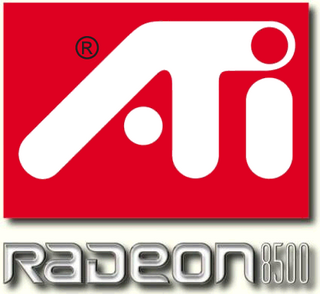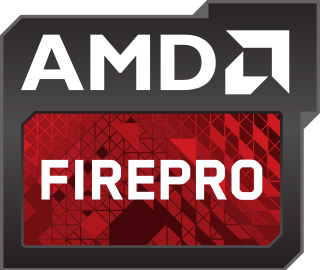
The GeForce 256 is the original release in Nvidia's "GeForce" product line. Announced on August 31, 1999 and released on October 11, 1999, the GeForce 256 improves on its predecessor by increasing the number of fixed pixel pipelines, offloading host geometry calculations to a hardware transform and lighting (T&L) engine, and adding hardware motion compensation for MPEG-2 video. It offered a notably large leap in 3D PC gaming performance and was the first fully Direct3D 7-compliant 3D accelerator.

ATI Technologies Inc., commonly called ATI, was a Canadian semiconductor technology corporation based in Markham, Ontario, that specialized in the development of graphics processing units and chipsets. Founded in 1985, the company listed publicly in 1993 and was acquired by AMD in 2006. As a major fabrication-less or fabless semiconductor company, ATI conducted research and development in-house and outsourced the manufacturing and assembly of its products. With the decline and eventual bankruptcy of 3dfx in 2000, ATI and its chief rival Nvidia emerged as the two dominant players in the graphics processors industry, eventually forcing other manufacturers into niche roles.

The GeForce 2 series (NV15) is the second generation of Nvidia's GeForce line of graphics processing units (GPUs). Introduced in 2000, it is the successor to the GeForce 256.

A graphics processing unit (GPU) is a specialized electronic circuit initially designed to accelerate computer graphics and image processing. After their initial design, GPUs were found to be useful for non-graphic calculations involving embarrassingly parallel problems due to their parallel structure. Other non-graphical uses include the training of neural networks and cryptocurrency mining.

The GeForce 4 series refers to the fourth generation of Nvidia's GeForce line of graphics processing units (GPUs). There are two different GeForce4 families, the high-performance Ti family, and the budget MX family. The MX family spawned a mostly identical GeForce4 Go (NV17M) family for the laptop market. All three families were announced in early 2002; members within each family were differentiated by core and memory clock speeds. In late 2002, there was an attempt to form a fourth family, also for the laptop market, the only member of it being the GeForce4 4200 Go (NV28M) which was derived from the Ti line.

Radeon is a brand of computer products, including graphics processing units, random-access memory, RAM disk software, and solid-state drives, produced by Radeon Technologies Group, a division of AMD. The brand was launched in 2000 by ATI Technologies, which was acquired by AMD in 2006 for US$5.4 billion.

The GeForce 6 series is the sixth generation of Nvidia's GeForce line of graphics processing units. Launched on April 14, 2004, the GeForce 6 family introduced PureVideo post-processing for video, SLI technology, and Shader Model 3.0 support.

The R200 is the second generation of GPUs used in Radeon graphics cards and developed by ATI Technologies. This GPU features 3D acceleration based upon Microsoft Direct3D 8.1 and OpenGL 1.3, a major improvement in features and performance compared to the preceding Radeon R100 design. The GPU also includes 2D GUI acceleration, video acceleration, and multiple display outputs. "R200" refers to the development codename of the initially released GPU of the generation. It is the basis for a variety of other succeeding products.

AMD FirePro was AMD's brand of graphics cards designed for use in workstations and servers running professional Computer-aided design (CAD), Computer-generated imagery (CGI), Digital content creation (DCC), and High-performance computing/GPGPU applications. The GPU chips on FirePro-branded graphics cards are identical to the ones used on Radeon-branded graphics cards. The end products differentiate substantially by the provided graphics device drivers and through the available professional support for the software. The product line is split into two categories: "W" workstation series focusing on workstation and primarily focusing on graphics and display, and "S" server series focused on virtualization and GPGPU/High-performance computing.
The R520 is a graphics processing unit (GPU) developed by ATI Technologies and produced by TSMC. It was the first GPU produced using a 90 nm photolithography process.

The Radeon R100 is the first generation of Radeon graphics chips from ATI Technologies. The line features 3D acceleration based upon Direct3D 7.0 and OpenGL 1.3, and all but the entry-level versions offloading host geometry calculations to a hardware transform and lighting (T&L) engine, a major improvement in features and performance compared to the preceding Rage design. The processors also include 2D GUI acceleration, video acceleration, and multiple display outputs. "R100" refers to the development codename of the initially released GPU of the generation. It is the basis for a variety of other succeeding products.
ATI Avivo is a set of hardware and low level software features present on the ATI Radeon R520 family of GPUs and all later ATI Radeon products. ATI Avivo was designed to offload video decoding, encoding, and post-processing from a computer's CPU to a compatible GPU. ATI Avivo compatible GPUs have lower CPU usage when a player and decoder software that support ATI Avivo is used. ATI Avivo has been long superseded by Unified Video Decoder (UVD) and Video Coding Engine (VCE).
Unified Video Decoder is the name given to AMD's dedicated video decoding ASIC. There are multiple versions implementing a multitude of video codecs, such as H.264 and VC-1.
The Evergreen series is a family of GPUs developed by Advanced Micro Devices for its Radeon line under the ATI brand name. It was employed in Radeon HD 5000 graphics card series and competed directly with Nvidia's GeForce 400 series.

AMD Radeon Software is a device driver and utility software package for AMD's Radeon graphics cards and APUs. Its graphical user interface is built with Qt and is compatible with 64-bit Windows and Linux distributions.
X-Video Bitstream Acceleration (XvBA), designed by AMD Graphics for its Radeon GPU and APU, is an arbitrary extension of the X video extension (Xv) for the X Window System on Linux operating-systems. XvBA API allows video programs to offload portions of the video decoding process to the GPU video-hardware. Currently, the portions designed to be offloaded by XvBA onto the GPU are currently motion compensation (MC) and inverse discrete cosine transform (IDCT), and variable-length decoding (VLD) for MPEG-2, MPEG-4 ASP, MPEG-4 AVC (H.264), WMV3, and VC-1 encoded video.
ATI Tray Tools (ATT) is a freeware program developed by Ray Adams for ATI Radeon video cards.
EVGA Corporation is an American computer hardware company that produces motherboards, gaming laptops, power supplies, all-in-one liquid coolers, computer cases, and gaming mice. Founded on April 13, 1999, its headquarters are in Brea, California. EVGA also produced Nvidia GPU-based video cards until 2022.

The Radeon HD 8000 series is a family of computer GPUs developed by AMD. AMD was initially rumored to release the family in the second quarter of 2013, with the cards manufactured on a 28 nm process and making use of the improved Graphics Core Next architecture. However the 8000 series turned out to be an OEM rebadge of the 7000 series.
The R200 is the second generation of GPUs used in Radeon graphics cards and developed by ATI Technologies. This GPU features 3D acceleration based upon Microsoft Direct3D 8.1 and OpenGL 1.3, a major improvement in features and performance compared to the preceding Radeon R100 design. The GPU also includes 2D GUI acceleration, video acceleration, and multiple display outputs. "R200" refers to the development codename of the initially released GPU of the generation. It is the basis for a variety of other succeeding products.











